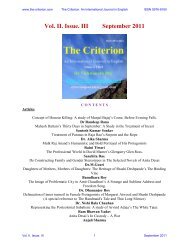PDF - The Criterion: An International Journal in English
PDF - The Criterion: An International Journal in English
PDF - The Criterion: An International Journal in English
You also want an ePaper? Increase the reach of your titles
YUMPU automatically turns print PDFs into web optimized ePapers that Google loves.
www.the-criterion.com<br />
<strong>The</strong> <strong>Criterion</strong><br />
<strong>An</strong> <strong>International</strong> <strong>Journal</strong> <strong>in</strong> <strong>English</strong> ISSN 0976-8165<br />
hunchback villa<strong>in</strong> of Shakespeare’s play than the real Richard, who was a rather nice man”<br />
(165).<br />
In order to understand such a widely accepted negative presentation of a royal figure,<br />
we must <strong>in</strong>itially reflect upon “history” as understood <strong>in</strong> Shakespeare’s day or the era<br />
preced<strong>in</strong>g his. Beth Marie Kosir <strong>in</strong> her article “Richard III: A Study <strong>in</strong> Historiographical<br />
Controversy” po<strong>in</strong>ts out that <strong>in</strong> that age:<br />
History was often used and studied to teach moral lessons. It fulfilled a dual<br />
purpose; it was for people to learn about and to learn from. consequently, to<br />
make history more palatable, or to make a stronger moral statement, bits of<br />
fiction were often spr<strong>in</strong>kled <strong>in</strong>to the description of actual events, <strong>in</strong> an effort to<br />
ensure that all those who partook of that history, either <strong>in</strong> written or oral form,<br />
had no doubt as to the moral of the story.<br />
(http://www.r3.org/bookcase/shaksper/Kosir.html).<br />
So, “history” was <strong>in</strong>tended to state a moral thesis, and people were satisfied with certa<strong>in</strong><br />
amount of fictionalization of it as long as the moral purpose was fulfilled. K<strong>in</strong>g Richard III<br />
has often been denoted <strong>in</strong> terms of the popular “Vice” of morality drama – for <strong>in</strong>stance,<br />
Bernard Spivack po<strong>in</strong>ts out that Richard’s dialogue with himself prior to the Battle of<br />
Bosworth is “precisely <strong>in</strong> the tradition of morality drama” (378); and for this purpose a<br />
blacken<strong>in</strong>g of his character has been effected. This idea establishes itself when we go through<br />
the diary account of Dom<strong>in</strong>ic Manc<strong>in</strong>i, a contemporary of Shakespeare. Manc<strong>in</strong>i never really<br />
refers to Richard’s deformities, what so ever, but rather defends him aga<strong>in</strong>st all allegations of<br />
hav<strong>in</strong>g master-m<strong>in</strong>ded his brother Clarence’s death. Manc<strong>in</strong>i blames the Queen and her<br />
supporters for the crime and states that Richard only attempted to avenge the death (105).<br />
Beth Marie Kosir makes an <strong>in</strong>-depth study of this controversy rag<strong>in</strong>g around the socalled<br />
fictionalized historical presentation of Richard III to comment:<br />
Richard III has been grist for both the literary and history mills for over five<br />
hundred years. Such noted personalities as Jane Austen, Sir Francis Bacon and<br />
Charles Dickens have found Richard to be a worthy topic for their literary<br />
efforts. Still, the debate over whether he was a good man or a bad man<br />
cont<strong>in</strong>ues to rage …..Richard deserved better treatment at the hands of both<br />
contemporary chroniclers and modern historians.<br />
(http://www.r3.org/bookcase/shaksper/Kosir.html).<br />
<strong>The</strong> very fact that a controversy has raged through centuries does po<strong>in</strong>t to the conception that<br />
certa<strong>in</strong> purposeful malign<strong>in</strong>g of the portrait of this last Yorkist ruler had <strong>in</strong>deed been effected.<br />
But it is almost impossible to believe that a sensitive, humanitarian author like Shakespeare<br />
would <strong>in</strong>dulge <strong>in</strong> bl<strong>in</strong>dly support<strong>in</strong>g any k<strong>in</strong>d of smear campaign aga<strong>in</strong>st a good ruler. Most<br />
of the historical facts known to Shakespeare gave him reasons to take Richard as a dark force<br />
throw<strong>in</strong>g the country <strong>in</strong>to chaos. So Shakespeare’s Richard III is every bit the villa<strong>in</strong> which<br />
contemporary history po<strong>in</strong>ts him out to be.<br />
III<br />
It is therefore quite natural that Shakespeare would utilise the popular appeal of the<br />
old Morality Plays, particularly the character of Vice, which may be supposed to embody<br />
many of man’s moral depravities. Shakespeare seems to have targeted Richard from the<br />
forego<strong>in</strong>g play Henry VI, Part 3 where he is made to glorify himself for some capabilities<br />
which reveal his evil nature:<br />
Why, I can smile, and murder whiles I smile,<br />
<strong>An</strong>d cry ‘Content!’ to that that grieves my heart,<br />
<strong>An</strong>d wet my cheeks with artificial tears,<br />
Vol. III. Issue. IV 5 December 2012
















